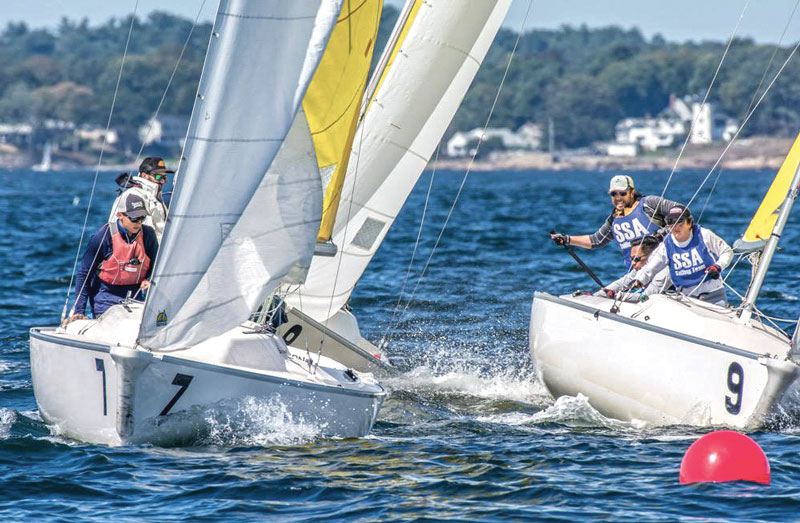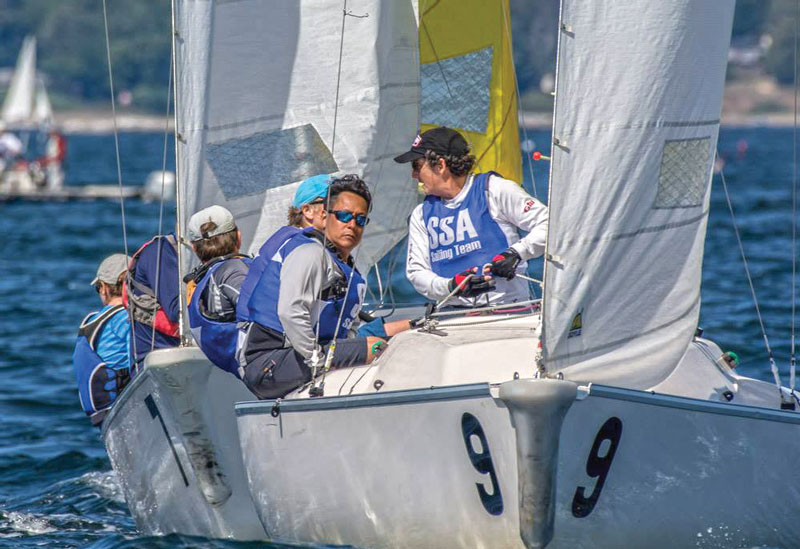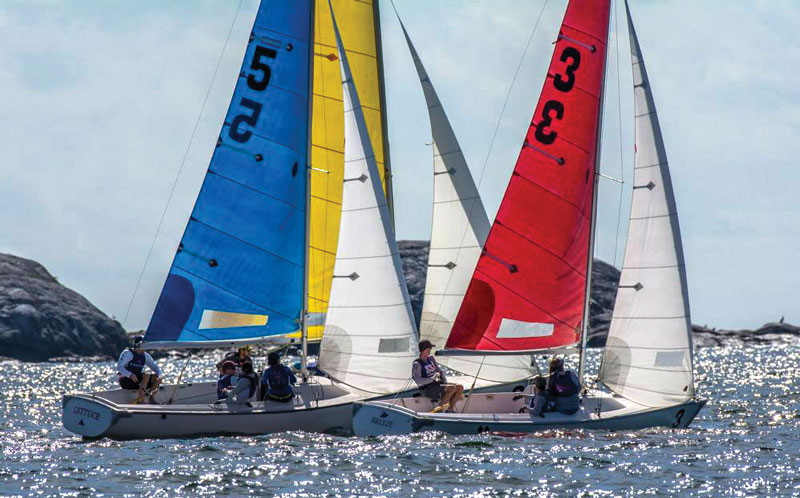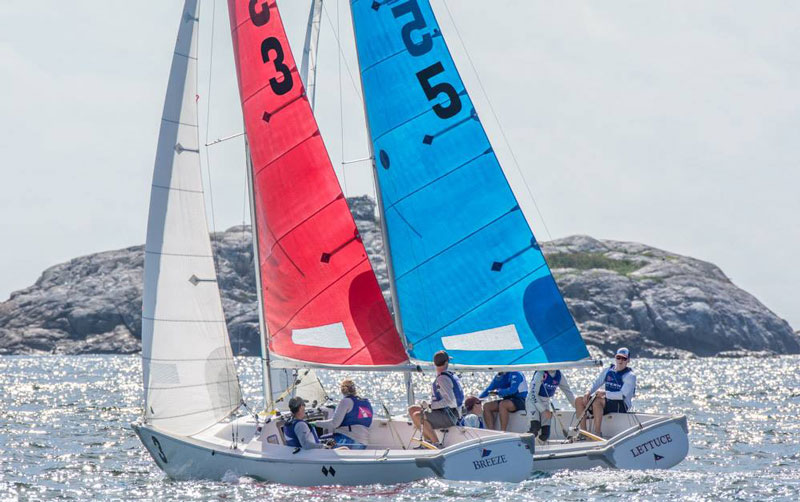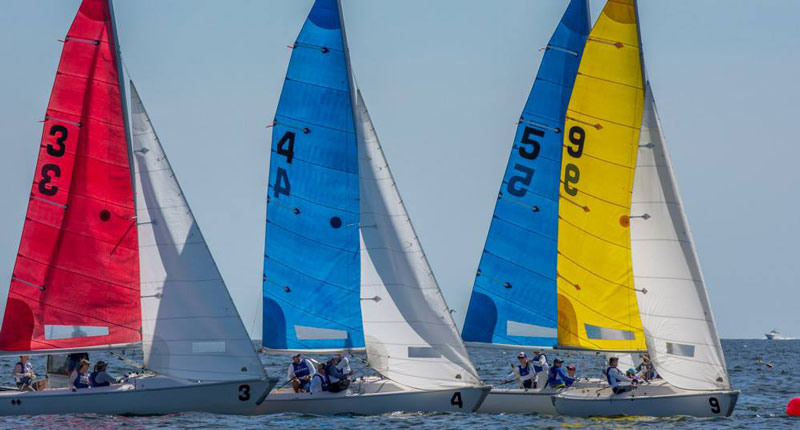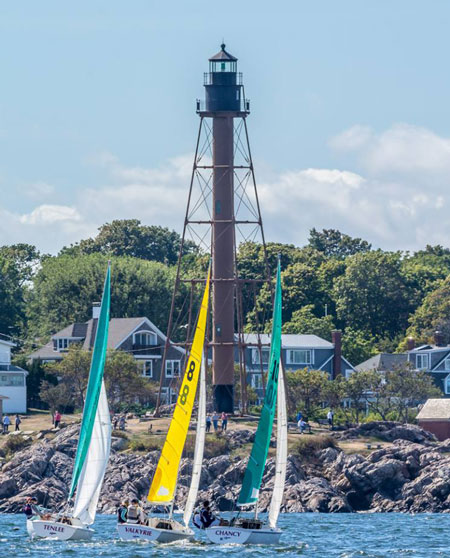We rounded the leeward mark in fourth place out of a tight pack of four boats with teammate Tim just in front of us. In two-versus-two team racing, this meant we were losing, and badly. Tim managed to break to weather of the second-place boat and hold his position, preventing the other boat from tacking. The first place boat immediately went in for the attack on Tim, allowing me to squeak around the leeward mark with a quick, clean tack. With the three of them clustered together and going slowly, I caught a puff and established myself in the first position. Tim tacked out on the layline as I swooped onto their Number One boat, keeping him stuck beneath me while Tim caught the breeze. With a photo finish we wound up winning with a one-two.
All of this happened within three minutes of action during the annual Hood Trophy Regatta, which happened this past September at Corinthian Yacht Club in Marblehead, MA. I had the privilege of representing SSA, along with Tim Herzog, Carol Cronin, Margaret and Sophie Podlich, Bill Carty, and Vernon Sheen. This is the second year that SSA has competed in the event, and we’re excited to try to bring a similar program to Annapolis. The clubs in Marblehead are on the vanguard of shared keelboat team racing and provide a nice model, which we in Annapolis should strive to recreate.
The Hood Trophy is a two-on-two team racing event held in 12 Sonars, pooled from the Corinthian, Eastern, and Boston Yacht Clubs, all located on Marblehead harbor. The separate teams had different colored mains to identify them on the water. There were eight teams competing, including local teams and teams from Rhode Island, Cape Cod and Buzzards Bay. The teams included competitors aged from their teens to their 60s, including several parent-child teams.
The event was structured as a double round robin followed by a knock out round to determine final results. With 12 boats available, there were three flights for races being run with two teams sitting out on a support boat waiting to swap in. We finished the first round robin with a sub .500 record but then found our stride going into the second round robin and ended up being the fifth seed for the knockout round. The knockout round operated on a bracket system, with teams competing in best-of-three-series to move forward. We won our first best-of-three matchup, lost our second against the top seed, and ended up losing a tight race with Boston Yacht Club to finish fourth at the event.
The entire weekend was a blast. In two-on-two team racing, the idea is simply that the team with the last boat loses, so there was action all around the course, and most races were settled in the last 50 yards to the finish. Our team had a lot of fun but with a constant refrain that we would be so much better if we did this more often.
That is where Marblehead has cracked the code.
Eight years ago, the clubs situated around Marblehead harbor got together to create interclub team racing. The Sonar fleet had been big in Marblehead, but was petering out as a one-design fleet racing class. Between the three clubs they acquired 14 Sonars and invested in a suit of team racing sails, which are only used for team racing events. The three clubs team race each other every Thursday night throughout the summer. Additionally, each club hosts its own team racing event: the Hood Trophy at Corinthian, the Halloween Team Race at Eastern, and the Jackson Cup at Boston.
This initiative has been a resounding success on many fronts. First and foremost, team racing is a great draw for the ever-elusive 20- and 30-something sailors, whom all clubs are seeking to attract. For those of us who participated in high school and college sailing, team racing is in our blood. But after graduation, there are limited resources to keep going in the sport. Each of the clubs in Marblehead has seen significant increases in their membership age group.
Second, keel boat team racing gets generations of sailors sailing together. We had a mother-daughter team with us in the Podlichs, but they were not alone in the fleet.
Third, team racing is a great way to generate interest in our sport. With tight racing on inshore courses with colorful sails, team racing is spectator-friendly and can draw more people in than offshore fleet racing.
Fourth, team racing in club boats creates the opportunity to draw talented sailors from afar to Annapolis. It was far easier to hop a flight to Boston to go sailing than it would have been to pack up my J/22 and trailer it to even another Mid Atlantic event.
Finally, team racing is just more fun than fleet racing! In team racing, the action never stops. From start to finish, you are working your hardest to out execute on boat handling, strategy, and tactics. And if you find yourself behind, you’ve got a teammate to bail you out.
We have a very similar dynamic here in Annapolis, and could easily recreate a similar program. We have three sailing clubs within close proximity (Annapolis Yacht Club is already hosting team racing events and practices). We have a surplus of high school and college sailors who have one-design experience. All we are missing is interclub boats and sails that would allow us to pace evenly with each other on the water.
--by Trevor Perkins
